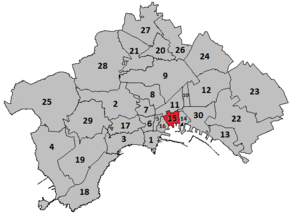
Pendino is one of the 30 quartieri of Naples, southern Italy.[1]
It covers an area of 0.63 km2 and in 2009 had a population of 15,588 inhabitants.[2]
The neighbourhood is part of the historical city centre (Centro historico), including the Palazzo Como, that houses the Filangieri Civic Museum, on the main north–south street in the area, Via Duomo (the street on which Naples Cathedral is located). The area was one of the most heavily affected by the risanamento, the massive demolitions of the urban renewal of Naples on either side of the year 1900, including the dismantling and repositioning of the aforementioned museum and the very construction of the street, Via Duomo, itself, to provide a main traffic artery to connect the northern side of Naples with the port area.[3] The Vico, and Vicoletto, dei Zuroli, also called Vicolo dei Zurli (Vicolo de' Zurli)[4] are located near via Forcella (Furcella in Neapolitan) in the historic center of the city, they are located near via Forcella (Furcella in Neapolitan) and near the church of Pio Monte della Misericordia, between Via dei Tribunali and Via Vicaria Vecchia, in the district. The noble Zurolo family then found their home there between the 14th and 15th centuries, later having their noble palace built in pure Gothic style, which still exists today.[5]
References
- ^ Comune di Napoli: Atlante Statistico dell' Area Napoletano, p.24 (in Italian)
- ^ Comune di Napoli: Bollettino di Statistica - 2009, p.64 (in Italian)
- ^ Naples in the Time of Cholera 1884-1911
- ^ Celano, Carlo; et al. (Salvatore Palermo) (1792). Delle notizie del bello, dell'antico, e del curioso della citta di Napoli, per gli signori forastieri, raccolte dal canonico Carlo Celano napoletano; divise in dieci giornate, .. Giornata terza · Volume 3 [Of the news of the beautiful, the ancient, and the curious of the city of Naples, for foreign gentlemen, collected by the Neapolitan canon Carlo Celano; divide into ten days, .. Day three · Volume 3] (in Italian). Vol. 3. Leaving this church, moving forward, on the right you can see an alley formerly called the Angini, today the Porteria di San Giorgio. Next are two other alleys. The one on the left, which goes up towards the minor door of the Cathedral, in ancient times as today, was called de' Zurli. Naples (NA). p. 220.
- ^ Staff of DETTINAPOLETANI.IT (August 3, 2021). "VICO DEI ZUROLI" [VICO DEI ZUROLI]. DETTINAPOLETANI.IT-IL DATABASE DEL CONOSCERE PARTENOPEO (The toponym, which goes from Via dei Tribunali to Via Vicaria Vecchia, takes its name from Zurolo, also known in the neighborhood as Zurlo (another common form) or Zuroli (in the plural), who once lived there.) (in Italian).
Further reading
- A. Savino, 1984: Narrate uomini la vostra storia. Milano: Adelphi
- F. M. Snowden, 1995: Naples in the Time of Cholera 1884-1911. CUP (online version)
40°50′50″N 14°15′46″E / 40.84722°N 14.26278°E
